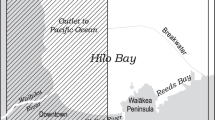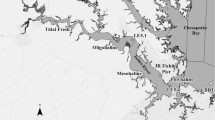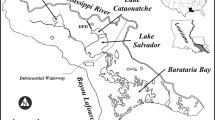Abstract
The chemical and biological impacts of anthropogenic physical modifications (i.e., channelization, dredging, bulkhead, and jetty construction) to tributaries were assessed on New York’s Long Island South Shore Estuary. Water-quality data collected on Carmans, Patchogue, and Swan Rivers from 1997 to 2005 indicate no significant differences in nutrient levels, temperature, or pH among the rivers, but significant differences in light transmittance, dissolved oxygen (DO), salinity, and sediments were observed. Patchogue River (PR) and Swan River (SR) were significantly more saline than Carmans River (CR), PR and SR had less light transmittance than CR, and both exhibited severe warm season hypoxia. CR was rarely hypoxic and only at the lower layer of the deepest station in warm seasons. Deep stations on PR had hypoxic readings year round, but the shallower SR was well-oxygenated at all stations after the fall turnover. There were wide diel and seasonal variations in chlorophyll a on each river, and measurements were significantly higher at poorly flushed stations. In warm seasons, this often resulted in hyperventilation with supersaturated DO in the upper water column on sunny days, and suboxic conditions at nights and/or in deeper layers. PR sediments were anoxic, SR sediments ranged from normal to anoxic, and CR sediments were normal at all stations. Polyaromatic hydrocarbon concentrations in PR sediments were over three orders of magnitude higher than SR and CR sediments. Benthic invertebrate assessment of species richness, biotic index, and Ephemeroptera, Plecoptera and Trichoptera richness indicated that PR was severely impacted, SR ranged from slightly to severely impacted, and CR ranged from non-impacted to slightly impacted. Diversity and abundance of plankton were comparable on SR and CR, and were significantly higher than on PR. The data indicate that nutrients do not play a major role in hypoxia in these estuarine tributaries but that physical forces dominate. The narrow inlets, channelization, and abrupt changes in depth near the inlets of PR and SR foster hypoxic conditions by inducing salinity stratification that limits vertical mixing and by restricting horizontal water mass exchange with the bay. The study suggests that other tributaries with such physical modifications should be examined to assess the temporal and spatial extent of hypoxia.





Similar content being viewed by others
References
Abele, L.E., J. Myers, R.W. Bode, and M.A. Novak. 1994. Biological stream assessment: Selected streams of Long Island, 1994 Survey. Albany, NY: NYS Department of Environmental Conservation.
Atasoy, M., R.B. Palmquist, and D.J. Phaneuf. 2006. Estimating the effects of urban residential development on water quality using microdata. Journal of Environmental Management 794: 399–408.
Beck, N.G., and K.W. Bruland. 2000. Diel biogeochemical cycling in a hyperventilating shallow estuarine environment. Estuaries 23: 177–187
Bode, R.W., M.A. Novak, and L.E. Abele. 1990. Biological impairment criteria for flowing waters in New York State. Albany, NY: NYS Department of Environmental Conservation.
Bode, R.W., M.A. Novak, and L.E. Abele. 1991. Methods for rapid biological assessment of streams. Albany, NY: NYS Department of Environmental Conservation.
Bode, R.W., M.A. Novak, and L.E. Abele. 2000. Invertebrate criteria for slow sand/gravel streams. Albany, NY: NYS Department of Environmental Conservation.
Borg, P., and E. Shreeve. 1974. The Carmans River story. Brookhaven, NY: Post-Morrow Foundation.
Borsuk, M.E., C.A. Stow, R.A. Luettich Jr., H.W. Paerl, and J.L. Pinckney. 2001. Modelling oxygen dynamics in an intermittently stratified estuary: Estimation of process rates using field data. Estuarine, Coastal and Shelf Science 52: 33–49.
Breitburg, D.L. 1990. Near-shore hypoxia in the Chesapeake Bay: Patterns and relationships among physical factors. Estuarine, Coastal and Shelf Science 30: 593–609.
Breitburg, D.L. 2002. Effects of hypoxia, and the balance between hypoxia and enrichment, on coastal fishes and fisheries. Estuaries 254B: 767–781.
Breitburg, D.L., L. Pihl, and S.E. Kolesar. 2001. Effects of low dissolved oxygen on the behavior, ecology and harvest of fishes: a comparison of the Chesapeake Bay and Baltic-Kattegat systems. In Coastal hypoxia: Consequences for living resources and ecosystems, eds. N.N. Rabalais, and R.E. Turner. Washington, DC: Coastal and Estuarine Studies 58, American Geophysical Union.
Breitburg, D.L., A. Adamack, K.A. Rose, S.E. Kolesar, M.B. Decker, J.E. Purcell, J.E. Keister, and J.H. Cowan. 2003. The pattern and influence of low dissolved oxygen in the Patuxent River, a seasonally hypoxic estuary. Estuaries 262A: 280–297.
Buzzelli, C.P., R.A. Luettich, S.P. Powers, C.H. Peterson, J.E. McNinch, J.L. Pinckney, and H.W. Paerl. 2002. Estimating the spatial extent of bottom-water hypoxia and habitat degradation in a shallow estuary. Marine Ecology Progress Series 230: 103–112.
Cerrato, R.M. 1986. A seasonal study of the benthic fauna in Moriches Bay. Marine Sciences Research Center, State University of New York, Stony Brook, NY. Special Report 72, Ref. 86–9.
Cerrato, R.M., and H.J. Bokuniewicz. 1985. The benthic fauna at four potential containment/wetlands stabilization areas. In Report to the New York District, U.S. Army Corps of Engineers. Stony Brook, NY: Marine Sciences Research Center, State University of New York.
Chapman, G. 1986. Ambient water quality criteria for dissolved oxygen. United States Environmental Protection Agency, Office of Water Regulations and Standards, Washington, DC, EPA 440/5-86-003.
Choi, K.S., and E. Blood. 1999. Modeling developed coastal watersheds with the agricultural non-point source model. Journal of the American Water Resources Association 352: 233–244.
Clesceri, L.S., A.E. Greenberg, and A.D. Eaton (eds.) 1998. Standard methods for the examination of water and wastewater, 20th ed. Washington, DC: American Public Health Association.
Cloern, J.E. 2001. Our evolving conceptual model of the coastal eutrophication problem. Marine Ecology Progress Series 210: 223–253.
Dennison, W.C., L.E. Koppelman, and R. Nuzzi. 1991. Water quality. In The Great South Bay, eds. , T.M. Bell, and H.H. Carter, 23–31. Albany, NY: State University of New York Press.
Diaz, R.J., and R. Rosenberg. 1995. Marine benthic hypoxia: a review of its ecological effects and the behavioral responses of benthic macrofauna. Oceanography and Marine Biology: An Annual Review 33: 245–303.
Gray, J.S. 1992. Eutrophication in the sea. In Columbo, G., Ferrari, I., Ceccherelli, V.U., Rossi, R. (eds.) Marine eutrophication and population dynamics. Olsen & Olsen, Fredensborg, p. 3–15.
Gray, J.S., R.S. Wu, and Y.Y. Or. 2002. Effects of hypoxia and organic enrichment on the coastal marine environment. Marine Ecology Progress Series 238: 249–279.
Heinz Center for Science, Economics and the Environment. 2002. The state of the nation’s ecosystems: Measuring the lands, waters, and living resources of the United States. New York, NY: Cambridge University Press.
Hilsenhoff, W.L. 1987. An improved biotic index of organic stream pollution. The Great Lakes Entomologist 201: 31–39.
Howell, P., and D. Simpson. 1994. Abundances of marine resources in relation to dissolved oxygen in Long Island Sound. Estuaries 17: 394–402.
Iriarte, A., I. Madariaga, M. Revilla, and A. Sarobe. 2003. Short-term variability in microbial food web dynamics in a shallow tidal estuary. Aquatic Microbial Ecology 31: 145–161.
Jones, S.M. 1999. Patchogue River maritime center plan. Hauppauge, NY: Suffolk County Department of Planning.
Karlsen, A.W., T.M. Cronin, S.E. Ishman, D.A. Willard, R. Kerhin, C.W. Holmes, and M. Marot. 2000. Historical trends in Chesapeake Bay dissolved oxygen based on benthic foraminifera from sediment cores. Estuaries 23: 488–508.
Keister, J.E., E.D. Houde, and D.L. Breitburg. 2000. Effects of bottom-layer hypoxia on abundances and depth distributions of organisms in Patuxent River, Chesapeake Bay. Marine Ecological Progress Series 205: 43–59.
Kemp, W.M., P.A. Sampou, J. Garber, J. Tuttle, and W.R. Boynton. 1992. Seasonal depletion of oxygen from bottom waters of Chesapeake Bay—Roles of benthic and planktonic respiration and physical exchange processes. Marine Ecology Progress Series 85: 137–152.
Koppelman, L.E., and D.S. Davies. 1990. Evaluation of land use impacts on environmental quality in urban and semi-rural streams tributary to Great South Bay, Long Island, New York. Hauppauge, NY: Long Island Regional Planning Board.
Llanso, R.J. 1991. Tolerance of low dissolved oxygen and hydrogen sulfide by the polychaete Strepblospio benedicti (Webster). Journal of Experimental Marine Biology and Ecology 153: 165–178.
Llanso, R.J. 1992. Effects of hypoxia on estuarine benthos: the lower Rappahannock River (Chesapeake Bay), a case study. Estuarine, Coastal and Shelf Science 35: 491–515.
Llanso, R.J., and R.J. Diaz. 1994. Tolerance to dissolved oxygen by the tubicolous polychaete Loimia medusa. Journal of the Marine Biological Association of the United Kingdom 74: 143–148.
Long Island Regional Planning Board. 1982. The Long Island segment of the nationwide urban runoff program. Hauppauge, NY.
Mahler, B.J., P.C. Van Metre, T.J. Bashara, J.T. Wilson, and D.A. Johns. 2005. Parking lot sealcoat: An unrecognized source of urban polycyclic aromatic hydrocarbons. Environmental Science and Technology 3915: 5560–5566.
Marcus, N.H. 2001. Zooplankton: responses to and consequences of hypoxia. In Coastal hypoxia: Consequences for living resources and ecosystems, eds. N.N. Rabalais, and R.E. Turner. Washington, D.C.: Coastal and Estuarine Studies 58, American Geophysical Union.
Monti, J. 2003. Trends in nitrogen concentration and nitrogen loads entering the South Shore Estuary Reserve from streams and ground-water discharge in Nassau and Suffolk Counties, Long Island, New York, 1952–1997. U.S. Geological Survey Water-Resources Investigations Report 02–4255. Denver, CO.
Moore, E. 1938. A biological survey of the fresh waters of Long Island. Supplement to the 28th Annual Report, State of New York Conservation Department. Albany, NY: J. B. Lyon Company.
Newcombe, C.L., and W.A. Horne. 1938. Oxygen-poor waters of the Chesapeake Bay. Science 88: 80–81.
New York State Department of Environmental Conservation (NYSDEC). 2000. Water quality assessment. Albany, NY.
New York State Department of Environmental Conservation (NYSDEC). 2004. New York State 2004 Section 303(d) List of impaired waters requiring a TMDL. Albany, NY.
Newton, A., and S.M. Mudge. 2005. Lagoon-sea exchanges, nutrient dynamics and water quality management of the Ria Formosa (Portugal). Estuarine, Coastal and Shelf Science 62: 405–414.
Niklitschek, E.J., and D.H. Secor. 2005. Modeling spatial and temporal variation of suitable nursery habitats for Atlantic sturgeon in the Chesapeake Bay. Estuarine, Coastal and Shelf Science 64: 135–148.
O’Connor, J.S. 1972. The benthic macrofauna of Moriches Bay. New York Biological Bulletin 142: 84–102.
Officer, C.B., R.B. Biggs, J.L. Taft, L.E. Cronin, M.A. Tyler, and W.R. Boynton. 1984. Chesapeake Bay anoxia: origin, development, and significance. Science 223: 22–27.
Parker, C., and J. O’Reilly. 1991. Oxygen depletion in Long Island Sound: A historical perspective. Estuaries 14: 248–264.
Pataki, G.E., and R.A. Daniels. 1997. Wetlands. South Shore Estuary Reserve technical report series. Albany, NY: New York State Department of State.
Pataki, G.E., and R.A. Daniels. 1998. Non-point sources of pollution. South Shore Estuary Reserve technical report series. Albany, NY: New York State Department of State.
Pataki, G.E., and R.A. Daniels. 1999. Summary report: South Shore Estuary Reserve water quality workshop. South Shore Estuary Reserve technical report series. Albany, NY: New York State Department of State.
Pataki, G.E., and R.A. Daniels. 2001. Long Island South Shore Estuary Reserve comprehensive management plan. Albany, NY: New York State Department of State.
Perillo, G.M.E., D.E. Perez, M. Cintia Piccolo, E.D. Palma, and D.G. Cuadrado. 2005. Geomorphologic and physical characteristics of a human impacted estuary: Quequen Grande River Estuary, Argentina. Estuarine, Coastal and Shelf Science 62: 301–312.
Pihl, L., S.P. Baden, and R.J. Diaz. 1991. Effects of periodic hypoxia on distribution of demersal fish and crustaceans. Marine Biology 108: 349–360.
Pilson, M.E.Q. 1985. On the residence time of water in Narragansett bay. Estuaries 8: 2–14.
Roman, M., A.L. Gauzens, W.K. Rhinehart, and J.R. White. 1993. Effects of low oxygen water on Chesapeake Bay zooplankton. Limnol. Oceanography 38: 1603–1614.
Roman, C.T., N. Jaworski, F.T. Short, S. Findlay, and R.S. Warren. 2000. Estuaries of the Northeastern United States: Habitat and land use signatures. Estuaries 236: 743–764.
Sanford, L.P., K. Sellner, and D.L. Breitburg. 1990. Covariability of dissolved oxygen with physical processes in the summertime Chesapeake Bay. Journal of Marine Research 48: 567–590.
SAS Institute. 2003. SAS Version 9.1. SAS Institute, Cary, North Carolina, USA.
Schimmel, S.C., S.J. Benyi, and C.J. Strobel. 1999. An assessment of the ecological condition of Long Island Sound. Environmental Monitoring and Assessment 561: 27–49.
Schroeder, W., K. Martin, and B. Lorensen. 2002. The Visualization Toolkit. 3rd ed. Kitware, Inc., USA.
Seliger, H.H., J.A. Boggs, and S.H. Biggley. 1985. Catastrophic anoxia in the Chesapeake Bay in 1984. Science 228: 70–73.
Slinger, J.H., S. Taljaard, and J.L. Largier. 1994. Changes in estuarine water quality in response to a freshwater flow event. In Changes in fluxes in estuaries: Implications from science to management. ECSA22/ERF Symposium, eds. R. Dyer, and R.J. Orth Olsen and Olsen, Fredensborg: Estuarine Research Federation.
Stalder, L.C., and N.H. Marcus. 1997. Zooplankton responses to hypoxia: Behavioral patterns and survival of three species of calanoid copepods. Marine Biology 127: 599–607.
Stanley, D.W., and S.W. Nixon. 1992. Stratification and bottom-water hypoxia in the Pamlico River estuary. Estuaries 15: 270–281.
StatSoft. 2006. Statistica version 7.1. StatSoft, Tulsa, Oklahoma.
Stephan, C.E., D.I. Mount, D.J. Hansen, G.H. Gentile, G.A. Chapman, and W.A. Brungs. 1985. Guidelines for deriving numerical national water quality criteria for the protection of aquatic organisms and their uses. US Environmental Protection Agency. NTIS publication no. PB85-227049.
Su, H-M., H-J. Lin, and J-J. Hung. 2004. Effects of tidal flushing on phytoplankton. Estuarine, Coastal, and Shelf Science 61: 739–750.
Suffolk County Department of Health Services. 1998. Sewage treatment plant synopsis report. Hauppauge, NY.
Tomas, C.R., G.R. Hasle, J. Throndsen (eds.) 1997. Identifying marine phytoplankton. New York, NY: Academic.
Turner, R.E., W.W. Schroeder, and W.J. Wiseman Jr. 1987. The role of stratification in the deoxygenation of Mobile Bay and adjacent shelf bottom waters. Estuaries 10: 13–19.
US Environmental Protection Agency. 2000. Ambient aquatic life water quality criteria for dissolved oxygen (saltwater): Cape Cod to Cape Hatteras. EPA-822-R-00-012. US Environmental Protection Agency, Office of Water Office of Science and Technology, Washington, D.C. and Office of Research and Development, National Health and Environmental Effects Research Laboratory, Atlantic Ecology Division, Narragansett, RI.
Yin, J., A. Falconer, and Y. Chen. 2004. Velocity and solute concentration distributions in model harbours. Maritime Engineering 157: 47–56.
Zajac, R.N., and R.B. Whitlatch. 2001. Response of macrobenthic communities to restoration efforts in a New England estuary. Estuaries 242: 167–183.
Acknowledgment
The Dorr Foundation of New York, NY, awarded seed funding in 1997 to initiate the Chemistry in Action Research Program at Dowling College and to undertake this study. Students Jennifer Burke, Dan Dillon, Gary Falta, Rich Lemke III, Michael Melia, Andrea Mercier, Steve Strawgate, Tony Tierno, and E. Christopher Williams were funded by the Dorr Foundation. Beth Nagle was funded by Dowling College as a Graduate Assistant, and Dowling College provided release time for faculty research. The Idle Hour Flyfishers Association funded research fellowships for students Shawn Fisher, Richard Lemke III, Mia Jurjevic, Audra Selvaggio, and Nicole Stella. Nicole Stella and E. Christopher Williams were also supported on Robert Noyce Scholarships from the National Science Foundation under award no. 03-35799. Any opinions, findings, and conclusions or recommendations expressed in this material are those of the authors and do not necessarily reflect the views of the National Science Foundation. John Egan (Emory University Law School) and Michael Nolan (University of Rochester) devoted substantial time to field and laboratory studies and to presentation of results to local governmental entities. Other students who contributed to field and laboratory studies were Rhonda Anjelly, Natasha Beria, William Capurso, Jennifer Cinquemani, Brihas Lara, Sean Madigan, Emily Montgomery, Anthony Monzon, Diana Muniz, Natalie Pedisich, Thomas Pettinato, and Sarah Porter. We appreciate the assistance of Bob Winowitch and Jack Monti of the United States Geological Survey with the taking of stream flow measurements and for providing electronic USGS map files for modification. We thank Jeff Kassner and Thomas Carrano of the Town of Brookhaven for the research vessel and staff to conduct field studies on Swan River.
Author information
Authors and Affiliations
Corresponding author
Rights and permissions
About this article
Cite this article
Zaikowski, L., McDonnell, K.T., Rockwell, R.F. et al. Temporal and Spatial Variations in Water Quality on New York South Shore Estuary Tributaries: Carmans, Patchogue, and Swan Rivers. Estuaries and Coasts: J CERF 31, 85–100 (2008). https://doi.org/10.1007/s12237-007-9010-y
Received:
Revised:
Accepted:
Published:
Issue Date:
DOI: https://doi.org/10.1007/s12237-007-9010-y




